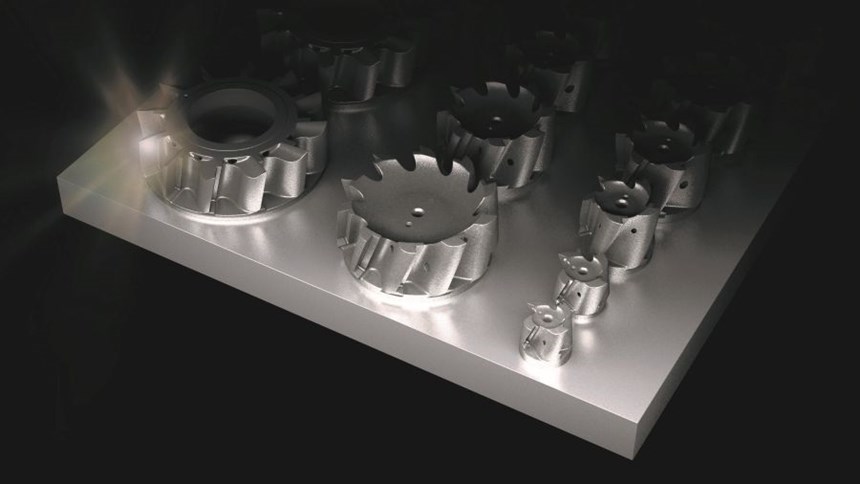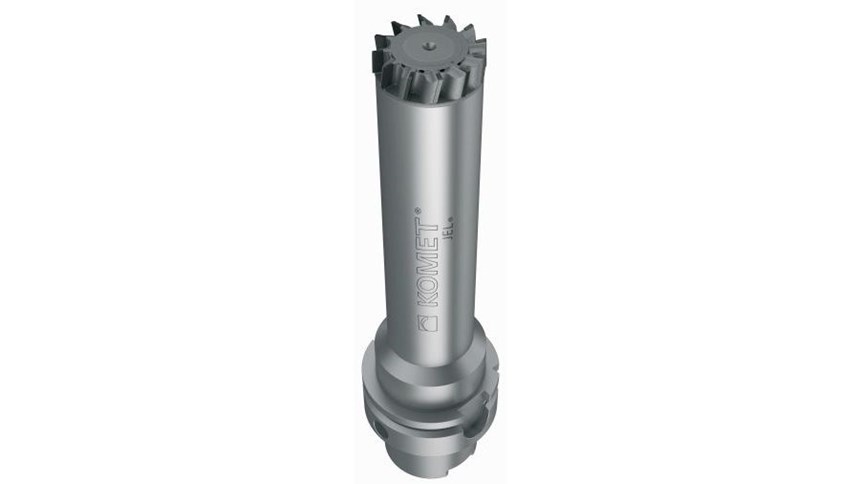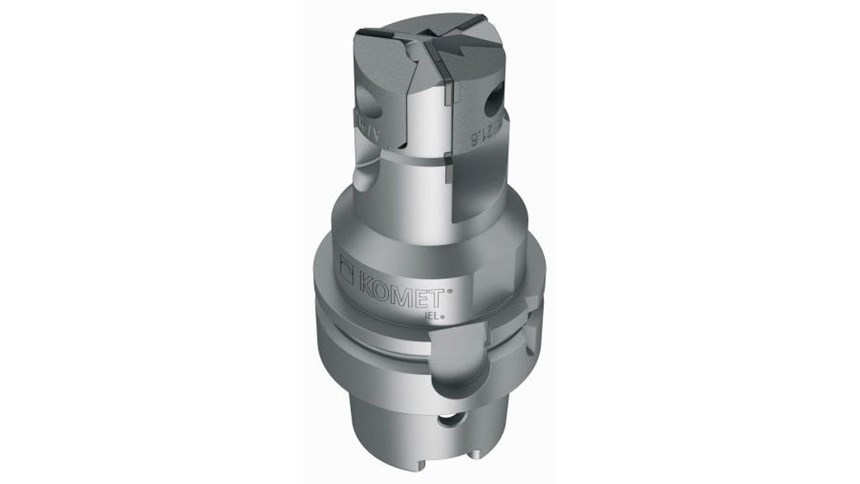Can Additive Manufacturing Increase Milling Feed Rates?
With PCD tooling, yes it can. The diamond cutting edges demand a large number of flutes to realize their full effectiveness. Traditional methods for making cutter bodies limit the number of flutes, but 3D printing is delivering tools with higher flute density and other enhancements as well.
The promise of additive manufacturing will be found in products that are designed for additive manufacturing—that is, products that take full advantage of the geometric freedom that 3D printing can realize. A recent successful example of this relates to milling cutters. Komet's “Revolution” line of milling tools includes tool bodies made through metal additive manufacturing to realize design features including a flute density higher than what is practical to achieve on coventionally manufactured tools. When it comes to cutting edges made of PCD (polycrystalline diamond), more flutes on the tool translates directly to faster feed rate. Thus, Komet is actually using additive manufacturing to make subtractive manufacturing more productive.
Company director of production Cullen Morrison sees making tool bodies through 3D printing as being the way of the future, at least for PCD. This cutting tool material often can take advantage of all the flutes it can get, he says. It is capable of such high material removal rates in the materials it typically cuts—aluminum and carbon fiber composite—that the number of flutes can be the limiting factor on feed rate and productivity. This is increasingly true as facilities using this tooling adopt modern machine tools with high acceleration rates. However, obtaining a high number flutes is problematic in cutter bodies made through machining, because the small pockets resulting form high flute density have to be milled out painstakingly using light cuts with small tools. Additive manufacturing offers a more efficient option.
Now, high-flute-density bodies are grown several at a time at Komet’s headquarters in Germany on a selective laser melting machine from Renishaw. After these bodies are separated via EDM from the build plate used in the additive process, they are ready for the PCD edges to be brazed on. Komet grows only the heads of the tools this way, laser welding them onto the shanks, because the shanks can be manufactured more economically in conventional processes.
Mr. Morrison says the advantages of additive manufacturing for the cutter heads go beyond flute density. There is also the flute pitch. Previously, a pitch of 4 to 5 degrees is the best the company could efficiently achieve, because the clearance challenges of reaching a cutting tool past the flute in order to mill out the pocket precluded a steeper angle than this. But in this case as well, the geometry consideration poses no challenge for additive. On the new tools, Komet has produced flute helix angles up to 20 degrees.
The 3D printed tools likely will also realize longer life, he says. The reason is coolant delivery. With additive, coolant channels can be grown inside the tool along snaking paths that exit precisely where the fluid can be most effective. On previous tools, the positioning of coolant channels was always a compromise resulting from the need to drill a straight hole past the clearance obstacles in the way of this drilling.
One other advantage of additive manufacturing might be the most transformative of all, he says: It will permit faster lead times for special tools. This advantage is particularly apparent to the Schaumburg, Illinois, Komet facility where Mr. Morrison works, because nearly all of the manufacturing here relates to specials. With 3D printing, the range of design options for these special tools increases, and unusual designs specified by special-order customers can move into production practically as soon as they are modeled.
It will take more additive manufacturing capacity to fully realize the promise of the capability for special orders, he says. The company is exploring how far to advance with this means of production, and how quickly. As yet, there is 3D printing capacity only in Germany. But even so, the lead time for 3D printed tool bodies made here is so fast that the distance is potentially no obstacle to serving customers in the U.S. efficiently. He says one possible scenario being discussed for custom tools is this: While the U.S. customer’s special cutter head design is grown additively in Germany, the Illinois facility can simultaneously machine that tool’s shank. The 3D printed head would then be sent to the U.S. and welded to the shank there, ultimately still allowing the tool be delivered within a much tighter window than today’s manufacturing methods make possible.
Related Content
3D Printing with Plastic Pellets – What You Need to Know
A few 3D printers today are capable of working directly with resin pellets for feedstock. That brings extreme flexibility in material options, but also requires greater knowledge of how to best process any given resin. Here’s how FGF machine maker JuggerBot 3D addresses both the printing technology and the process know-how.
Read More3D Printed Titanium Replaces Aluminum for Unmanned Aircraft Wing Splice: The Cool Parts Show #72
Rapid Plasma Deposition produces the near-net-shape preform for a newly designed wing splice for remotely piloted aircraft from General Atomics. The Cool Parts Show visits Norsk Titanium, where this part is made.
Read More8 Cool Parts From Formnext 2024: The Cool Parts Show #78
End-use parts found at Formnext this year address various aspects of additive's advance, notably AM winning on cost against established processes.
Read MoreBeehive Industries Is Going Big on Small-Scale Engines Made Through Additive Manufacturing
Backed by decades of experience in both aviation and additive, the company is now laser-focused on a single goal: developing, proving and scaling production of engines providing 5,000 lbs of thrust or less.
Read MoreRead Next
Crushable Lattices: The Lightweight Structures That Will Protect an Interplanetary Payload
NASA uses laser powder bed fusion plus chemical etching to create the lattice forms engineered to keep Mars rocks safe during a crash landing on Earth.
Read More3D Printed Polymer EOAT Increases Safety of Cobots
Contract manufacturer Anubis 3D applies polymer 3D printing processes to manufacture cobot tooling that is lightweight, smooth and safer for human interaction.
Read MorePostprocessing Steps and Costs for Metal 3D Printing
When your metal part is done 3D printing, you just pull it out of the machine and start using it, right? Not exactly.
Read More
























